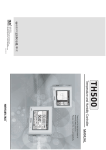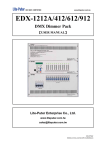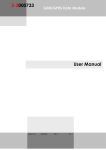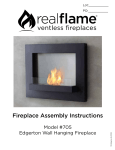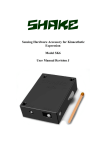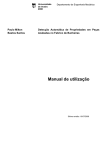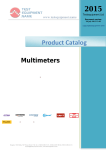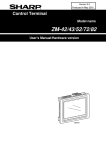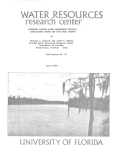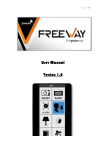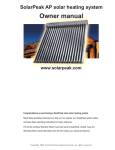Download Instruction Manual
Transcript
#1381-3, Juan-dong, Nam-gu, Incheon, Korea TEL:(82-32) 876-4697 FAX:(82-32) 876-4696 http://www.hynux.com E-mail: [email protected] MA01E50110 Recorder & Temperature Controller RT9 INSTRUCTION MANUAL Thank you for the purchase of HANYOUNG product. Please read this manual carefully. Contents 1. SAFETY INFORMATION 4 2. INSTRUCTION 6 3. ORDERING INFORMATION 6 4. SPECIFICATION 7 5. DIMENSIONS & PANEL CUTOUT 11 6. TERMINAL ARRANGEMENT 11 7 NAME & FUNCTION 12 8. TABLE OF SETTING ITEMS 13 10. SETTING METHOD 15 20. GROUP SETTING 16 21. FUNCTION 23 2 RT9 Universal Input Output / Small-sized Recorder & Temperature controller ( 0.3 class high accuracy) Model : RT9 Features Zoom function Free scale Various Alarms PID Auto tuning Universal Input Record and Temperature Output control Interface (RS485) 3 1 SAFETY INFORMATION Before using, please read this (SAFETY INFORMATION) It is most important that the instructions in this manual are followed when using this instrument. Please keep this manual for future reference. Precautions are classified as WARNING and CAUTION. WARNING There is a possibility of death or heavy injury when handling in wrong way. CAUTION There is a possibility of injury or physical damage when handling in wrong way. WARNING 1. Caution on wiring Use an external protection circuit if a fault in the control loop could possibly lead to a serious problem. This instrument does not have a switch for power and a fuse, so please install them if reguired. (Fuse rating 250V, 0.5A) 2. Power supply Use a rated voltage to prevent damage or trouble. To avoid electrical shock or damage, do not turn ON the power until the wiring is completed. 3. Prohibit use in gas atmosphere Do not use it at a place exposed to combustible or explosive gas. 4. Handling of unit To avoid malfunction, electrical shock or fire, this unit must not be disassembled or repaired. Do not touch the terminals to avoid electrical shock or malfunction. 5. Caution on maintenance Turn OFF the power before mounting or removing the instrument. To ensure continuous and safe operation of the instrument, periodical maintenance is recommended. Some parts are limited in life. The warranty period is 1 year only if using in the correct way. CAUTION 1. Caution on handling Do not install the instrument under any of the following condltions. The ambient temperature exceeds 0 ~ 50 The ambient humidity exceeds 20 ~ 90%RH. A place where temperature changes suddenly or icing occurs. A place exposed to corrosive gas or combustible gas. Vibration or shock is likely to be transmitted to the instrument. A place exposed to water, oil, chemicals, steam, sunlight. A place exposed to much dust, salt or iron. A place with much inductive disturbance, static electricity, magnetism noise. A place where heat such as radiant heat stays. 4 2. Installation Attach the brackets (2 units) on the fixed halls and tighten with a screwdriver. Fixing torque is about 14.7N. cm (1.5kg.cm). (Care should be taken not to tighten forcedly.) Indoor use. Altitude up to 2000m use. Mains supply voltage fluctuations not to exceed 10 of the normal voltage. Installation Categories Pollution degree 2 3. Caution on terminal connections Use a compensating cable with thermocouple. For R.T.D input use a cable which is a small lead wire resistance and without resistance difference to 3wires. To avoid inductive noise to input wires separate from the power and output wires. Keep input wires away from output wires and use shielded wires to earth. If the wiring has noise, use the following step: connect a surge absorber to the conductor coil side if the conductors are connected to the load output, such as the relay contact output. Use an insulating transformer with a noise filter when the power suppy has much noise. Noise filter should be mounted on a panel which has been earthed and the wiring between the noise filter output and the instrument power terminals should be shorten. It is effective to use a twisted cable for power supply against noise. The heater power supply and the instrument power supply should be connected using the same power suppy when a heater break alarm. Time for preparation of contact output is required at power ON. When the output signal is used for an extenal interlock circuit, connect a delay relay. 4. For load circuit connection Use an extra relay when the frequency of operation is rather high. In this case, SSR output type is Recommended. Electromagnetic switch : Proportional cycle time is Min. 30 sec SSR : Proportional cycle time is Min. 2 sec Contact output life : Mechanical : Min. 10 million times (no load) Electrical : Min. 100 thousand times (rated load) SSR drive pulse voltage, DC 4~20mA are not insulated with internal circuit. Use non-grounded sensor to R.T.D and thermocouple. 5. Caution on key operation / trouble If alarm function is not set correctly, alarm output can not operate correctly a trouble. Be sure to check the alarm operation. If the input cable is disconnected, the display shows “ ”. When replacing the sensor, please turn OFF the power supply. 6. Other Do not use organic solvents such as alcohol, benzine when cleaning. (Use neutral detergent) 5 2 INSTRUCTION This instrument has process-value (PV) and set-value (SV) each 4 digits with 7 segment FND. This instrument is divided either Recorder and Recorder with Controller. Function and feature : Group P.I.D, Universal-input (19 types), Universal-output (Relay, SSR, SCR), Auto-tuning 2 types (standard type, low PV type), Communication (RS485), 20 types of alarm, Sampling cycle 250ms, 0.3 of FS high accuracy. And there are Zoom function, Graphic or Text printing selectable function, List printing function, Feed function, Free scale function. RT9 is the smallest Recorder with controller. 3 ORDERING INFORMATION Model RT9 - Description 96 96 mm Recorder Recorder & Temperature Controller Suffix code 0 1 0 1 Others None Alarm 1 Alarm 1, 2 RS485 RS485 / Alarm 1 RS485 / Alarm 1, Alarm 2 0 1 2 3 4 5 Control output Recorder & Temperature Controller RT9 - 1 Output code Control Output 0 1 2 3 Relay (ON / OFF control) SSR SCR (4 ~ 20 mA DC) Relay (P.I.D control) 6 4 SPECIFICATION INPUT Input Sampling time Input resolution Input impedance Lead wire tolerable resistance Input tolerable voltage Noise removal rate Standard Standard junction temp. compensation tolerance Burn-out Accuracy Input range Thermocouple : K, J, E, T, R, S, B, L, N, U, WRe 5-26, PLR.T.D : Pt 100 , KPt 100 Direct voltage: 1 ~ 5 V, -10 ~ 20 mV, 0 ~ 100 mV (Free scale type) 250 mS Below decimal point of measurement range T/C and mV input : 1 min., V DC : 1 R.T.D : 10 max. / wire 10 V (T/C, R.T.D, Voltage : mV DC), 20 V (Voltage : V DC) NMRR(normal mode) : 40 dB min. CMRR(common mode) : 120 dB min. (50/60 Hz 1 %) T/C, R.T.D: KS, IEC, DIN 1.5 (15 ~ 35 ), 2.0 (0 ~ 50 ) T/C : OFF, Up/Down selectable R.T.D : Up scale (Detection current : 50 mA) 0.3 % (Full scale) Refer to “Input signal and Measurement range” T/C and R.T.D are changeable within range of input signal and measurement range. Voltage: min. voltage and max. voltage are available within range of measurement. Scaling available. OUTPUT CONTROL OUTPUT Relay contact output SSR drive voltage output Current output (4 ~ 20 mA DC) Contact capacity : 240 V AC 3 A, 30 V DC 3 A (resistive load), Contact : 1 C Output operation : P.I.D control, ON/OFF Proportional cycle : 1 ~ 1,000 sec. Output limit : 0.0 ~ 100.0 % range, higher limit(OH) or lower limit(OL) selectable (valid when AT) ON/OFF hysteresis : 0 ~ 100 %(Full scale) Time resolution : 0.1 % or 10 mS ON voltage : 24 V DC min.(resistive load 600 min., 30 mA limit when short) OFF voltage : 0.1 V DC max. Proportional cycle : 1 ~ 1,000 sec. Output operation : P.I.D control Output limit : 0.0 ~ 100.0 % range, higher limit(OH) or lower limit(OL) selectable (valid when AT) Time resolution : 0.1 % or 10 mS Current output range : 4 ~ 20 mA DC, Resistive load : 600 max. Accuracy : 0.5 % of full scale (4 ~ 20 mA range), Resolution : Approx. 3,000 Output ripple : 0.3 %(P-P) of max. scale (150 Hz) Sampling time : 250 mS Output operation : P.I.D control Output limit : -5.0 ~ 105.0 % range, higher limit(OH) or lower limit(OL) selectable (valid when AT) 7 ALARM Relay contact output Contact capacity : 240 V AC 1 A, 30 V DC 1 A(resistive load) Contact: 1 a Output points: 2 Points (AL1,AL2) FUNCTION Measurement input Control Alarm output Record Input correction (Bias): -100.0 ~ 100.0 % for instrument range Scaling : According to SH, SL of measurement range Filter : OFF, 1 ~ 120 sec. 3 settings (SV1, SV2 and SV3) and P.I.D setting each Auto tuning : According to set value (Standard type, Low PV type) Proportional Band : 0.1 ~ 999.9 % (Max. range) Integral Time : OFF, 1 ~ 6000 sec. Derivative Time : OFF, 1 ~ 6000 sec. ON/OFF control : By selecting output code (OT) “ 0 ” P.I.D selection : Zone PID/Auto 1,2,3, selectable Manual Reset : -5.0 ~ 105.0 % of output (valid when I=OFF) Direct / Reverse action : Changeable by parameter Preset output limit : -5.0 ~ 105.0 % of output value ON/OFF hysteresis (HYS) : 0.0 ~ 100.0% of instrument range (valid when ON/OFF control) A.R.W(Anti Reset Wind-up) : AUTO, 50.0 ~ 200.0 % Fuzzy : selection ON or OFF by parameter Ramp function Set point : 2 Points Multi-alarm : High/Low process alarm, High/Low deviation alarm, Hold function of alarm, Heater break alarm (H.B.A) Setting range : Process alarm 0 ~ 100 % of instrument range Deviation alarm -100 ~ 100 % of instrument range Measuring point : 1 Response time : According to chart speed Record type : Thermal line, 203 dpi(8.0 dots/mm) 384 dots / 1 line Record speed : 24 mm/h ~ 900 mm/h Paper : Width 57.5 mm, Length 16 m OPERATING ENVIRONMENT Continuous vibration (5~14Hz): Forward width 1.2 mm max. (4~150Hz): 4.9 (0.5 G) max. Installation environment Vibration : 14.7 , 15 sec. max. (each 3 direction) Shock : 147 (15 G), 11 msec max. (6 direction each 3 times) Panel cutout: Refer to page 11 Ambient temperature : 0 ~ 50 Normal operation Ambient humidity : 35 ~ 85 % RH (no condensation) condition Influence of magnetic : 400 AT/m max. Warm-up time: 30 min. min. T/C, Voltage input : 1 V/ or 0.01 %/ of max. range Influence of ambient R.T.D input : 0.05 / max. temperature Analog output : 0.05 %/ max. (continuous output) 8 STORAGE CONDITION Storage temperature Storage humidity Shock -25 ~ 70 5 ~ 95 % RH (no condensation) 1 m max. in packing condition STRUCTURE MODEL RT9 External Dimension 96(W) 96(H) 100(D) mm Weight 530 g Material Plastic case(ABS) POWER SUPPLY Power supply Frequency Power consumption Insulation resistance Dielectric strength 100 ~ 240 V AC (90 ~ 264 V AC) 50/60 Hz 6.0 W max., 10 VA max. Between primary terminal and secondary terminal : 500 V DC, 20 min. Between primary terminal and ground : 500 V DC, 20 min. Between ground and secondary terminal : 500 V DC, 20 min. Between primary terminal and secondary terminal : 2,300V AC 50/60 Hz for 1 min. Between primary terminal and ground : 2,300 V AC 50/60 Hz for 1 min. Between F G and secondary terminal : 1,500 V AC 50/60 Hz for 1 min. SAFETY AND EMC STANDARD Safety standard EMC standard Under process Under process INTERFACE Standard Communication address Communication method Synchronization Communication sequence Communication distance Communication speed Start bit Data bit Parity bit Stop bit Communication protocol Response time EIA RS485 Max. 31 (1 ~ 99 setting available) 2 wire half duplex or 4 wire half duplex Start-stop synchronous mode None 1.2 Km max. 600, 1200, 2400, 4800, 9600 BPS (Speed is changeable by parameter) 1 BIT 7 or 8 BIT None, even numbers, odd numbers 1 or 2 BIT PC LINK WITHOUT SUM(0), PC LINK WITH SUM(1) Reception treatment time + (Response time 10 mS) 9 INPUT SIGNAL and MEASUREMENT RANGE Input code K 1 2 K 2 2 J 3 2 E 4 2 T 5 2 R 6 2 B 7 1 S 8 L 9 2 N 10 U 11 2 W 12 13 Platinel 20 KSPt 100 3 21 3 Pt 100 30 1 ~ 5 V DC 31 0 ~ 10 V DC -10 ~ 20 mV DC 32 0 ~ 100 mV DC 33 Input type (Input signal) Thermo -couple (T.C) R.T.D Direct voltage (V DC / mV DC) Direct 4 ~ 20 mA DC Current Range ( ) Range( ) -300~2500 -200~1370 0~2300 -199.9~999.9 -199.9~999.9 -300~2300 -199.9~999.9 -300~1800 -199.9~400.0 -300~750 32~3100 0~1700 32~3300 0~1800 32~3100 0~1700 -199.9~900.0 -300~1300 -300~2400 -200~1300 -199.9~400.0 -300~750 32~4200 0~2300 32~2500 0~1390 -199.9~500.0 -199.9~999.9 -199.9~640.0 -300~1180 1~5V 0 ~ 10 V DC -10 ~ 20 mV 0 ~ 100 mV When using current input, use the resistor 30 250 0.1 % on input terminal. 10 Accuracy 0.3 % of F.S 1 digit Remarks F.S is maxium value ~ minimum value of each RANGE. Digit is minimum value of display 0.3 % of F.S 1 digit 1 0.3 % of F.S 1 digit 0 ~ 400 : 10 % 1.0 % of F.S 1 digit of F.S 1 digit 0.3 % of F.S 1 digit 2 0 and below : 1.0 % of F.S 1 digit 0.3 % of F.S 1 digit 3 -150.0~150.0 range : 1.0 % of F.S 1 digit 20 21 KPt 100 DPt 100 5 DIMENSIONS & PANEL CUTOUT RT9 (96 6 (Unit : mm) 96 mm) TERMINAL ARRANGEMENT RS 485 Terminal structure Control Output POWER Input AL1 / AL2 Communication Relay(Terminal no. ) SSR / SCR (Termina no. ) 100 - 240 V AC 50/60 Hz. (Termina no. Termocouple: +, R.T.D: A, B Direct Voltage : +, Alarm1 (Terminal no. ) Alarm2 (Terminal no. ) Sending data ( ) Receiving data ( ) Earth for signal( ) 11 ) 7 NAME & FUNCTION Front Displays Name P.END RUN AL1 AL2 Set-value(SV) Process-value(PV) AT OUT RT9 HANYOUNG Functions No paper Recording in progress Alarm 1 ON Alarm 2 ON Displays set value and various parameters.(RT9-0 : Displays input type) Displays the process value. When setting, displays various modes. Flickers when the auto tuning operates. Lights when the control output is ON. Model name Manufacturer Control keys Functions Key Used to change mode. Used to increase set-value. Used to decrease set-value. Used to select digit for changing. 12 8 TABLE OF SETTING ITEMS Power ON Operation Menu screen Operation display status. 3 sec. Set value changeable Group Control Group Autotuning Group P.I.D Output volume display Set a number Parameter structure Recorder only (RT9-0): Control group Alarm group (Optional) Communication group (Optional) Input group Time setting group will be displayed. 13 Group Alarm Group Communication Group Output 14 Group Input Group Time setting 9 SETTING METHOD After completion of wiring, apply power ON. Management version indicated as below and then present PV and SV will be indicated. (Record exclusiue use : Input type and PV will be indicated) For setting a level, press button for 3 sec. to enter setting mode.(Initial value : In the condition, press button to enter group control. Parameter shift Power ON Recorder& Controller (Model:RT9-1) Recorder (Model:RT9-0) Recorder : Displays input type and PV Recorder & controller : Displays SV and PV For 3 sec How to operate RECORDER RUN Press buttons simultaneously (RUN lamp will be ON) Stop Press buttons simultaneously (RUN lamp will be OFF) Graphic or Text printing selection In condition of printing, press button for 3 sec.(Graphic Text Graphic ...) List printing In condition of printing, press button for 3 sec. Feed paper In condition of press button, press button to feed paper. Group Control Group Control Group Auto tuning Group PID Group Alarm Group Alarm Group Communication Group Communication Group Output 15 Group Input Group Input Group Time setting Group Time setting ) 10 GROUP SETTING Display level setting Signal Display Name Description Condition Divide display levels into Always Display level setting 3 stages (1~3) This controller has 3 different levels of setting, thereby restricting operator access if so desired. Initial 3 Control group setting Signal Name Description Condition Initial Control group display Set a control mode Always Zone selection 1 OFF / ON Except ON/OFF OFF Fuzzy function OFF / ON Always OFF Initial increasing temperature OFF / EUS (0~100 %) Always OFF Initial decreasing temperature OFF / EUS (0~100 %) Always OFF Time unit HOUR / MIN Always HOUR Set speed of transmission 24 ~ 900 mm/hour Always 60 Zoom OFF / ON Always OFF 16 Auto tuning group setting (Model: RT9-1) Signal Name Description Condition Auto tuning group Indicates Auto-turing RT9-1 Auto tuning type / ABS STD ABS OFF Auto tuning start OFF / 1~3 / Initial Auto-tuning The Auto tuning function automatically measures, computes and set the optimum P.I.D value. Note After setting all group, select AUTO in Auto tuning group. Auto-tuning type This controller has two types of auto tuning as STD (standard type) and Low. (Low PV type : SV-10%) Auto-tuning start stop Auto tuning start : 1~ 3 selection (After auto tuning , P.I.D value will be stored at a selected number) Selection When setting a value on 1.RP and 2.RP, it is stored in group 1,2,3 automatically Auto tuning stop : Select OFF P.I.D Group setting (Model: RT9-1) Signal Name Description Condition P.I.D group Set P.I.D mode RT9-1 Anti Reset Wind-up Auto / 50.0 ~ 200.0 % Except ON/OFF Auto P.I.D group selection 0/1~3 Always 0 n.Proportional band (P) 0.1 ~ 999.9 % P.I.D group 5.0 % n.Integral time (I) OFF / 1 ~ 6000 sec P.I.D group 240 sec n.Derivative time (D) OFF / 1 ~ 6000 sec P.I.D group 60 sec n.Manual reset -5.0 ~ 105.0 % Integral time : OFF 50.0 % n.Zone position EU(0) < 1.RP < 2.RP < EU(100.0 %) ZONE : ON EU (100.0 %) 17 Initial Maximum Range (Eu:100%) Zone 3 Set point of Zone 2 (2,RP) Zone 2 Set point of Zone 1 (1,RP) Zone 1 Time Minimum (Eu: 0%) When checking P.I.D. values or setting SV in manual mode, this can be done in P.I.D. Group. Press key to get Anti Reset Wind value by auto or manual and then press once more to be indicated P.I.D mode which is selectable 3 types of P.I.D group (0~3). Example, “0” is no P.I.D mode and after seleting “1” using or and pressing , it is available to change P.I.D value in zone “1”. (“2” and “3” are same as “1”) When integral time is OFF, manual reset mode is indicated and then you could set reset value to remove off set. (range: -5 % ~ 105.0 % of proportional band). You could set 3 zones by selecting zone mode ON. Alarm group setting (Optional) There are 2 alarm outputs available per controller. In Alarm Group, setting are made for mode, dead band and value of each alarm. Refer to the next page for the 20 different types of alarm functions. Signal Name Alarm group Type of Alarm 1 Type of Alarm 2 Description Condition Set alarm mode Optional Initial value 1 OFF / 1 ~ 22 Refer to Alarm type and code Always EUS ( 0.0 ~ 100.0 % ) Always EUS(0.5%) PV alarm, Deviation alarm: EU ( -100.0 ~ 100.0 % ) Always EU(100.0%) EU(0.0%) 2 Dead band of Alarm 1 Dead band of Alarm 2 Set value of Alarm 1 Set value of Alarm 2 Reference : Display lamp will be OFF when output ON in inverted type. 18 ALARM TYPE AND CODE (Notice) : Display lamp will be ON when output OFF in inverted type. Hysteresis Code NO. ( : Set point , Alarm type 1 High absolute value 2 Low absolute value 3 High deviation value 4 Low deviation value 5 High deviation value (inverted) 6 Low deviation value (inverted) 7 High Low deviation value 8 High Low band 9 High absolute (inverted) 10 Low absolute (inverted) 11 High absolute with hold function 12 Low absolute with hold function 13 High deviation with hold function 14 Low deviation with hold function 15 16 17 18 19 20 : Minus Alarm set point , Function High deviation with hold function (inverted) Low deviation with hold function (inverted) High Low deviation with hold function High Low band with hold function High absolute value with hold function (inverted) Low absolute value with hold function (inverted) Marked alarms are not available in RT9-0 19 : Alarm set point ) Communication group setting (Optional) RT9 series is equipped with 4 wire /2 wire half-duplex the RS485 / RS422 communication interfaces. Using the interfaces, communications are available with maximum 31 devices. Signal Name Communication group RS485/RS422 Protocol Communication rate (B.P.S) Description Set communication mode Condition Initial value Optional PC.LINK(Set value:0) / PC.LINK SUM (Set value:1) 600(SV:0) / 1200(SV:1) / 2400(SV:2) 4800(SV:3) / 9600(SV:4) 0 4 Parity check NONE(SV:0) / EVEN(SV:1) / ODD(SV:2) Stop bit 1bit (SV:1) / 2bit (SV:2) Data length 7bit (SV:7) / 8bit (SV:8) (Except PC LINK :8) 8 Address 1 ~ 99, maximum 31 devices 1 Response time 0 ~ 10. response time = (handling time + response time) X 10 ms 0 1 Optional 1 Output group setting (Model : RT9-1) Signal Name Description Condition Initial value Output group Output type and mode selection Output signal Refor to type of control output Always 3 Output operation REV: Reverse DIR: Direct action Always REV Cycle time 1 ~ 1000 sec Relay / SSR 30 sec Hysteresis EUS(0.0 ~ 100.0 %) ON/OFF Control 0 Always 0.0 % Output volume when input -5.0 ~ 105.0 % disconnection Output (Out) Maximum value of output OL-L + 1 Digit ~ 105.0 % Minimum value of output -0.5 % ~ OL-H-1 Digit Model:RT9-1 Except ON/OFF Except ON/OFF 100.0 % 0.0 % CAUTION When setting, Input type selection number must be selected in the input type selection mode and also Output type selection number must be selected in the output type selection mode before moving to other mode. If not, data of other group will be changed to prior value. Output is selectable among Relay, SSR and Current(4 ~ 20 mA DC). For Recorder & Controller, output code 0 ~ 3 are available for your use. 20 Input group setting Signal Name Input group Description Condition Input type and mode selection Initial value Always Input signal selection Refer to input signal and range Always Selection NO.1 High limit Always 1370 Always -200 Low limit Refer to input signal and range ( Notice : FR-H > FR-L ) Decimal point (on voltage input) Maximum on scale (on voltage input) Minimum on scale (on voltage input) Thermocouple or R.T.D : Not available On voltage input (mV,V) DC Voltage : 0~3 PV filter OFF/1~120sec Always OFF PV bias EUS (-100.0~100.0%) Always EUS(0.0 %) Burn-out OFF / UP / DOWN Always UP -1999~9999 Notice : SL-H SL-L Deimal point : according to DP-P On voltage input (mV,V) 1 100.0 0.0 CAUTION When setting, Input type selection number must be selected in the input type selection mode and also Output type selection number must be selected in the output type selection mode before moving to other mode. If not, data of other group will be changed to prior value. Input type selection After power ON and when PV is indicating, press key for 3 sec to be displayed at PV and 3 at SV. (If it is not indicated 3, set again in the level setting mode) Control group is indicated when press key once more. At the time, input group is indicated when press key and then Input type and range selection is shown at SV when press . At this time the input and range is selected by or key. Press key to confirm Maximum and Minimum range Press key to set Maximum and Minimum range using or key. Press key once more to finish. , Decimal point Parameter is not indicated in T.C and R.T.D input, but when selecting voltage input Decimal point mode is indicated. (set 1 : 0.0, set 2 : 0.00, set 3 : 0.000) Maximum and Minimum on scale It is the same function as Maximum and Minimum Range setting when R.T.D or thermocouple input. This mode is indicated when voltage input ( 30, 31, 32, 33 ) 21 PV filter When PV value becomes unstable due to effects of noise, the filter helps suppress the unstable status. (Range: OFF or 1 ~ 120 sec. initial value: OFF) PV bias Use this function to adjust PV value in cases where it is necessary for PV value to agree with another recorder or indicator, or when the sensor cannot be mounted in correct location. (Range : -100.0 ~ 100.0 % of SPAN, lnitial value : 0.0 %) Setting a value using , or key and press key to finish. Time group setting Signal Name Description Condition Time group Set Y, M, D, T. Always Set Year 2000 ~ 2099 Always Present value Set Month 1 ~ 12 Always Present value Set Day 1 ~ 31 Always Present value Set Hour 0 ~ 23 Always Present value Set Minute 0 ~ 59 Always Present value Set Second 0 ~ 59 Always Present value 22 Initial value 11 FUNCTION AUTO TUNING max. value of measuriag range (SV) The Auto tuning function automatically measures, computes and sets the optimum Proportional band(P), Integral time(I), and Derivative time(D). When Auto-tuning, the controller performs ON/OFF control and determine proper P.I and D. (Limit cycle type) RT9-1 series have two types of Auto-tuning as below. PID 3 Reference point 2 PID 2 Reference point 1 PID 1 Time (t) min. value of measuring range RAMP FUNCTION Standard type auto-tuning : This type is based on set point value (SV) Low PV type auto-tuning : This type is based on the value 10 % lower than the set point value (SV) It is a rate of set value to arrive to set value according to setting temperature and time. ex)Present temp. 20 , set value 100 , 20 per min. Initial uprising set value(up,rt) : 100 Unit time : Minute (min) STANDARD TYPE AUTO-TUNING Under AT Temperature AT finished AT started 100 Set point value (SV) 80 Process value (PV) 60 Time (t) Control output ON OFF OFF ON ON ON/OFF operation Present Time (t) temp 20 PID control LOW PV TYPE AUTO-TUNING AT finished AT started Set point value (SV) SV-10% Process value (PV) Time (t) Control output ON OFF ON OFF ON ON/OFF operation Time/Min 1 2 3 4 ZOOM FUNCTION Under AT Temperature 40 Time (t) PID control Auto-tuning in Zone PID Zone PID automatically sets PID group in accordance with a measured value. In Zone PID, auto-tuning sets the proper PID value by recognizing a mid-value of reference point as set point value. 23 When you choose Zoom function ON in Group control, you can see a temperature with zooming as soon as you select ON. The temperature will be in the center of paper. ex) Scale : 0.0 ~ 100.0 Zoom ON : ZOOM IN PV : 25.5 at the center FUZZY CONTROL HOLD FUNCTION Fuzzy control eliminates overshoot using Fuzzy Logic. Employing Fuzzy control and Autotuning, the controller effectively control as below. When the controller starts control at the position which has a big gap between SV and PV. When reducing warming up time When the load is fluctuating extreamly When changing a set point value frequently Set point value Without hold function, Low limit alarm will be ON when increasing temperature. (Picture 1) Hold function : None PV SV (low limit alarm) Power ON Alarm output ON OFF ON OFF (Picture 1) Subsidary target value Target set value Hold function PV measured value SV (low limit alarm) Fuzzy Logic start Time (t) Power ON Alarm output OFF OFF ON OFF OUTPUT LIMIT Control output is set in high and low limit as operating range. Output limit is -5 ~ 105 % of output. (Picture 2) RECORDER Run/Stop : You can record or stop when you need. Feed : Paper can be transmitted forcedly. Graphic or Text selectable Output signal 20 mA 12 mA Graphic 4 mA Text Output limit (%) -5 % 50 % OL-L setting range 105 % OL-H Emergency output When A/D error or input disconnection occur in auto mode, PID output is cut and than Pre-set output is operated. (PO Output) List printing : You can check and keep an important data which is set in each parameter. 24 MEMO


























